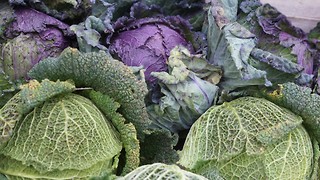Anna’s Culinary Corner
Anna contemplates fad diets, eating insects, Victorian favourites, and the tipsy cake

A few weeks back, I found myself at a cheeky five-course mid-week dinner at St John’s. The dinner exceeded your standard formal not only in the number of courses but also in its vintage factor: the crux of the event was to transport the diners back in culinary time to the 19th century, with Victorian favourites such as clear vegetable broth, braised venison, and Prince Albert’s tipsy cake featured on the menu. Fancying myself something of a culinary Doctor Who, I was somewhat dismayed to hear our guest speaker – the fellow-turned-food journalist and therefore my idol Bee Wilson – declare at the end of the meal that culinary history cannot, in fact, be authentically recreated and that our food was more noughties than Victorian. Fair enough: having opted for the vegetarian version, I wasn’t quite sure how popular stuffed peppers were with the Victorians (or even if vegetarianism was a thing in an era whose cookbooks seemed to favour carnivores). However, I was genuinely devastated to discover that our al dente carrots should have been cooked to near mushiness to be authentic and that our tipsy cake (in effect a mince pie-type pastry) was not nearly boozy enough to qualify as ‘tipsy’.
Gradually emerging from the depths of the initial shock of having blown multiple Sainsbury’s basics products’ worth of money on a not-so-historically-accurate dinner, I ended up researching food history, spending more time on this than I’d like my supervisor to know. With one shocking discovery after the other, I started to feel grateful that the dinner turned out to be, although disappointingly modern, safe and digestable. Compared with all the perils of culinary time travel, not-alcoholic-enough tipsy cake becomes a very minor worry.
Take fad diets, for instance. You might think that the lose-weight-and-sex-up craze belongs to our modern era of Atkins and 5-2 diets but, believe me, history has seen it all – arsenic, tapeworms, and even cabbage soup, you name it and someone has dieted on it. Forget about Beyoncé going vegan and Angeline Jolie filling her plate with ancient grains, one of the first celebrity dieters was Lord Byron swearing in the name of vinegar. To lose weight, the poet took to drinking the stuff daily and eating potatoes soaked in it. Feel like running for the bathroom? This was exactly the sought after side-effect of the diet: there is nothing like vomiting and diarrhoea to cast off a few kilos. However, the vinegar diet did not remain a one-man experiment. Just as today, the effect of celebrities on youth was a cause of widespread worry as young Romantics took to surviving off rice and vinegar to achieve the Byronesque pale and thin look. Some things never change.
It’s not only the Victorians and other people beyond living memory that had, well, interesting ideas when it comes to food. For some curious experiments, rewinding a few decades is enough. My favourite discovery from the past century is gelatin salads. While gelatin nowadays is mainly associated with the slightly artificial touch it brings to cakes, jellies, and other sweet treats, savoury gelatin was all the rage in the Fifties. Dinner party specials included lime-flavoured gelatin with mayonnaise, cucumber, and canned tuna embedded in it and, as a somewhat mealier salad option, unflavoured gelatin with bits of turkey, chicken, carrots, and green beans floating around. I won’t be the first to book a place on a Fifties dinner if one ever comes up.
Now fast-forward 50 years, and you’re in for another gut-clenching culinary experiment. While weaver ants are a well-established Thai delicacy, and the menus of many African countries regularly feature goodies such as termites, fried, smoked, steamed, sundried, or ground into a powder, insect food is a much shunned option in Western cuisine. Yet creepy crawlies present one of the most effective solutions to an impending global food crisis. By 2050, planet Earth will be home for nine billion people, with a sharply rising demand for animal products in low- and middle-income countries. Combine with this the huge environmental burden that the global livestock industry is already now, and you have a nourishment bomb in your hands.
Insects, however, may be able to save the day. They are packed with protein and essential micronutrients such as iron and zinc; a beetle requires less space than a cow; insects emit lower levels of greenhouse gases; and a kilogram of feed yields 12 times more edible cricket protein than beef protein. If tucking into a crunchy cricket isn’t your idea of a nice snack, there are plenty of more discreet options available. Cricket flour, for instance, can be easily incorporated into anything from burgers to brownies, while the US-based company Six Foods has hit upon chirps, or cricket crisps. Peckish, anyone?
And so my lamentation of missing out on the authenticity of Victorian overcooked carrots turned into gratitude for not being subjected to vinegar. That said, I’d quite like to be around when John’s in a couple of hundred years’ time puts on a 21st-century dinner with quinoa, cupcakes, and couscous salads on the menu – will the diners be devastated to discover that the early Noughties recipes did not, in fact, involve cricket flour?
 News / ‘Out of the Ordinary’ festival takes over Cambridge 26 August 2025
News / ‘Out of the Ordinary’ festival takes over Cambridge 26 August 2025 News / Government pulls £277M in funding for Cambridge sewage works relocation25 August 2025
News / Government pulls £277M in funding for Cambridge sewage works relocation25 August 2025 Comment / Who could possibly want more exams?25 August 2025
Comment / Who could possibly want more exams?25 August 2025 News / Tompkins Table 2025: Trinity widens gap on Christ’s19 August 2025
News / Tompkins Table 2025: Trinity widens gap on Christ’s19 August 2025 Music / Spotify substitutes: can ethical streaming sound just as good?26 August 2025
Music / Spotify substitutes: can ethical streaming sound just as good?26 August 2025









